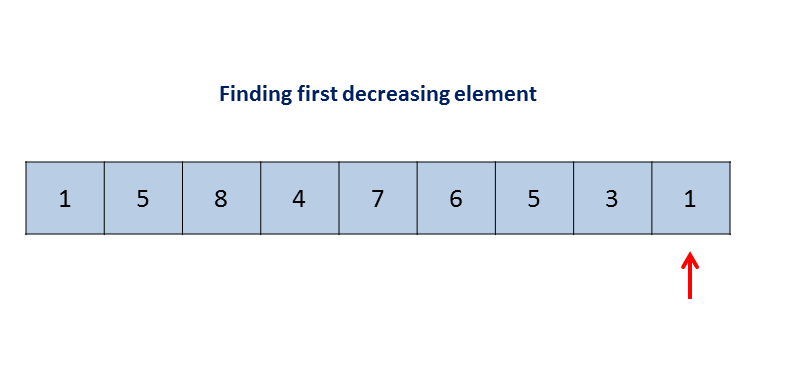Implement next permutation, which rearranges numbers into the lexicographically next greater permutation of numbers.
If such arrangement is not possible, it must rearrange it as the lowest possible order (ie, sorted in ascending order).
The replacement must be in-place, do not allocate extra memory.
Here are some examples. Inputs are in the left-hand column and its corresponding outputs are in the right-hand column.
1,2,3→1,3,2
3,2,1→1,2,3
1,1,5→1,5,1
大致意思是给定一个数字的排列,要求我们求得下一个更大的排列,如果已是最大的排列,则下一个应是最小的排列。另外本题还要求我们必须原址操作数组,不开辟额外的数组空间。
举个例子,比如给定一个数组[5,3,4],将数组中3个数字的全排序由小到大输出如下:
3,4,5
3,5,4
4,3,5
4,5,3
5,3,4
5,4,3
当前排列5,3,4的下一个排列就是5,4,3,而5,4,3的下一个排列则为3,4,5。
求解此问题,我们当然可以暴力的列出全排列并进行排序,但是这种解法的时间复杂度高达O(n!)
下面的动态图直观的演示了本题最优解的求解过程,这种解法的时间复杂度仅为O(n)
 Next_Permutation.gif
Next_Permutation.gif
由上图可知,该解法共分三个步骤:
- 从右向左(数组下标由大到小)扫描,找到第一个降序的元素a[i-1].
- 再从a[i-1]向右扫描,找到最后一个比a[i-1]大的元素a[j](仅比a[i-1]大一点),交换a[i-1]和a[j],该操作保证了在i-1位置上的值比之前大且大的最少,交换之后i-1后面的子序列仍为降序排列。
- 反转i-1后面的子序列,使子序列变为升序排列保证子序列最小。如果一开始给的排列就是降序的,通过该这个翻转操作即可得到升序排列。
代码如下:
public class Solution {
public void nextPermutation(int[] nums) {
int i, j;
for(i = nums.length - 1; i > 0; i--)
{
if(nums[i-1] < nums[i]) // 找到第一个降序的元素nums[i-1]
break;
}
if (i > 0)
{
for(j = nums.length - 1; j > i - 1; j--) // 这里是从右向左扫描
{
if(nums[j] > nums[i-1]) // 找到仅比nums[i-1]大一点的元素nums[j]
{
swap(nums, i - 1, j);// 交换nums[i-1]和nums[j]
break;
}
}
}
reverse(nums, i); // 反转i-1后面的子序列
}
private void reverse(int[] nums, int start) // 反转从start开始的子序列
{
int i = start, j = nums.length - 1;
while (i < j)
{
swap(nums, i, j);
i++;
j--;
}
}
private void swap(int[] nums, int i, int j) // 交换nums[i]和nums[j]
{
int temp = nums[i];
nums[i] = nums[j];
nums[j] = temp;
}
}




网友评论